- 1International Potato Center, The Consultative Group on International Agricultural Research (CGIAR) Research Program on Roots, Tubers and Bananas, Lima, Peru
- 2The Consultative Group on International Agricultural Research (CGIAR) Research Program on Roots, Tubers and Bananas, Servas, France
- 3Universidad Nacional Daniel Alcides Carrión, Paucartambo, Peru
- 4International Potato Center, The Consultative Group on International Agricultural Research (CGIAR) Research Program on Roots, Tubers and Bananas, Hanoi, Vietnam
Potato late blight (LB), caused by the oomycete, Phytophthora infestans, continues to be a major constraint of potato in the Andean region and worldwide. Farmers perception regarding potato production with particular emphasis on management practices for LB was surveyed in two communities in the Peruvian highlands using a questionnaire with 25 questions, many with multiple choice questions. In the village of Paucartambo, 84 women and 485 men of different ages participated in the survey, while in the village of Ulcumayo, there were 146 women and 396 men, also of different ages. Overall, responses were similar between the two locations, with some small but significant differences. In general, there was a very clear association between age and education, with only young men and women having secondary education. Respondents in both locations overwhelmingly chose LB as the main constraint to production and cited either personal experience or agrochemical vendors as the primary sources of information about disease management. Many cultivars (25+) are grown in both locations, with the two most important cultivars, Yungay and Huayro, being common in both locations while others differed. There was evidence of confusion around the concept of host plant resistance, as certain cultivars were cited as both relatively resistant and susceptible. Many trade names of fungicides were recalled by respondents, but most were relatively old products. Correspondence analysis indicated gender effects on LB management practices and information sources in both locations that could be taken into consideration to refine future interventions for research and capacity building, such as offering refresher training courses for extension educators, including female extension workers, to help farmers understand basic concepts to manage host resistance and fungicides properly, and improve access to resistant varieties and effective fungicides.
Introduction
Potato is a staple food throughout the Andes and is often the primary source of income for farmers in highland communities (Devaux et al., 2020). Late Blight (LB) caused by the oomycete Phytophthora infestans, continues to be a major constraint of potato in the Andean region and worldwide (Adolf et al., 2020) resulting in large economic costs and dependence on pesticides. In the European Union, the total cost of LB due to both direct yield loss and fungicide use was estimated at €6 billion by Haverkort et al. (2009), and in the United States, the total losses due to LB were estimated $3.5 billion (Nowicki et al., 2012). In lower-income countries, particularly in the highland tropics, LB can be very problematic because of near year-round potato production and thus the threat of disease occurring throughout the whole crop cycle (Garrett et al., 2001). As a result of the prevalence and epidemic potential of the pathogen, fungicide use has become a routine aspect of potato production in most areas where the crop is produced. LB is also particularly problematic in lower income countries because of health risks to resource poor farmers who frequently apply fungicides with no protective equipment (Cole et al., 2007). Simulation modeling has shown that LB will become more severe in some highland tropical areas, as for example the Andean Highlands and the highlands of Ethiopia and the Lake Kivu region (Sparks et al., 2014).
The disease management capacity of farmers is another important factor affecting LB severity in low income countries, where farmers have difficulty understanding this complex disease due to insufficient knowledge of underlying processes (Ortiz et al., 2004) and an inability to see the causal organism with the naked eye (Sherwood and Bentley, 1995). Thus, it is important for farmer training programs on potato LB management to put sufficient attention on learning key technical aspects of diseases that are not visible to farmers (Damtew et al., 2020). Furthermore, while farmers play a key role in the LB control by making decisions in their own fields, they are also affected by the management strategies of other farmers in the landscape, especially from those who fail to control disease in their potato plots, which can act as inoculum sources (Pacilly et al., 2016). Therefore, it is important to consider LB as a collective action problem whose management requires a corresponding re-configuration in information sharing and communicative practices (Damtew et al., 2020).
Tafesse et al. (2018) proposed that to effectively manage plant diseases, farmers need to learn about the diseases and how to manage them in their local context applying a feasible combination of management options through a community-based approach. An assessment of Farmers Field Schools (FFS) in Peru indicated that participants were more knowledgeable than non-participants at the end of the training and that their expertise was further increased after an additional year of participation (Ortiz et al., 2004). Farmers can also be influenced by other information sources, such as traders who may have their own objectives and interests (Pacilly et al., 2016). Women and men farmers play different roles in crop management, and they often have different knowledge, information, and decision-making power according to their roles and intra-household relationships (Kawarazuka et al., 2020; Okonya et al., 2021). Understanding gender differences can help improve FFS to address specific needs and knowledge gaps of women and men farmers, respectively.
As a weather driven disease, LB is often managed at the farm level with the aid of a decision support system (DSS). These are generally computer-supported and require relatively precise input data and thus are not appropriate for resource poor farmers (Pérez et al., 2020). The International Potato Center (CIP) recently developed a simplified DSS that does not require complex data or computers, but it was proposed that even a simplified DSS should be introduced with training (Pérez et al., 2020).
A baseline study can help orient and improve the success of any capacity building intervention with farmers (Förch et al., 2014). One such survey conducted in Peru, Bolivia, Ecuador, and Uganda between November 1997 and August 1998 reported that farmers in all the participating countries relied on fungicides to control LB. However, most farmers did not know how to differentiate contact fungicides from systemic fungicides, and the intensity of fungicide sprays was related with farmers' education level, farmer's age, size of farm, and planting date but not with susceptibility of potato cultivars (Ortiz et al., 1999). In Kenyan highlands, a survey reported that farmers overwhelmingly (98%) relied on application of fungicides to control LB, however, the high cost of fungicide, poor application techniques, and preference of susceptible cultivars contributed to an inadequate control of the disease (Nyankanga et al., 2004).
In the preparation of farmer training in two regions of Peru, CIP implemented a baseline survey of potato farmers with the objective of learning more about the communities and their current practices and knowledge of LB management. This paper reports the results of the surveys and attempts to draw conclusions that could improve a future capacity building program.
Materials and Methods
Questionnaire and Survey
A semi-structured questionnaire (Supplementary Material 1) was used to conduct a survey among small-scale farmers between November 2016 and June 2017, in two important potato growing areas in the central Peruvian Highlands: Paucartambo, in the department of Pasco, and Ulcumayo, in the department of Junin. Both areas are known to have high LB disease pressure. Farmers' houses and their potato plots were located between 2,422 and 4,209 m.a.s.l. and all participants had agriculture as the main economic activity and potato as the primary crop. A draft questionnaire was validated previously with socio-economists and pathologists from the CIP and subsequently with 10 farmers from each area. Some questions were focused on characteristics of respondents: age, gender, education level and altitude. Others focused on main potato constraints, the causes of LB, criteria of selection of fungicides, frequency of fungicide applications, fungicide dosages, number of cultivars grown, identification of cultivars resistant and susceptible to LB, and yield losses (Table 1).

Table 1. Number of respondents with different education levels by age and gender class in Paucartambo and Ulcumayoa.
Participants
In total, 1,198 farmers were interviewed with the final version of the questionnaire. Farmers involved in this study were randomly selected from each place to reflect potential differences in potato production technologies, late blight management, and pesticide use. All respondents came from different households.
Data Analysis
Responses were first assessed individually or in pairs in tabular or graphical form. Where possible, associations between factors were tested with Chi-square or Wilcoxon rank sum tests. The majority of responses were also assessed in a multivariate correspondence analysis (CA, Nenadic and Greenacre, 2007). CA is based on a contingency table, and to create this for the survey results, many responses leading to continuous scales were made into discrete classes (Supplementary Material 2). For the contingency table, age-gender classes (young men, young women, mid aged men, mid aged women, senior men, and senior women) were used as rows so that these respondent characteristics could be compared against management perceptions, which formed the columns of the table. Management options were often modified.
Two rows and several variables were treated as supplementary in the CA, i.e., their location on a biplot is estimated but they are not used to form the plot dimensions. The two rows were young women and senior women, because they had relatively few representatives and would have thus had strong effects in the CA. Supplementary columns included education levels low, medium and high, altitude levels low, medium and high, resistant cultivar as Yungay, resistant cultivar as other, susceptible cultivar as Canchan, susceptible cultivar as other, spray interval 1–8 days and spray interval more than 8 days. Education related columns were made supplementary because of their very strong correlation with age. The other columns were made supplementary because they had overly strong effects in the analysis but were not deemed that important by the survey designers. Statistical and correspondence analyses were done in R (R Core Team, 2018).
Results
Characteristics of Respondents
There were 569 and 542 respondents participating in the surveys in Paucartambo and Ulcumayo, respectively (Table 2). There was an even distribution of ages, spanning a range from below 20 years to 80 or more years in both locations (Figures 1A,B). Both males and females were represented across the age distribution, except in Paucartambo where there were no women below 30 (Figure 1A). Women made up 37.1% of the respondents in Ulcumayo, but only 6.8% in Paucartambo (percentages calculated from Table 1).
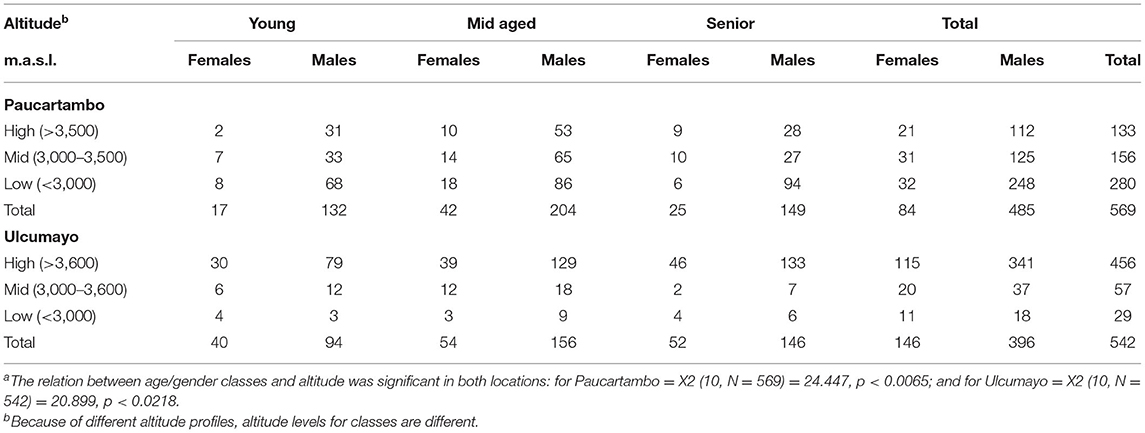
Table 2. Number of respondents in different altitude ranges by age and gender class in Paucartambo and Ulcumayoa.
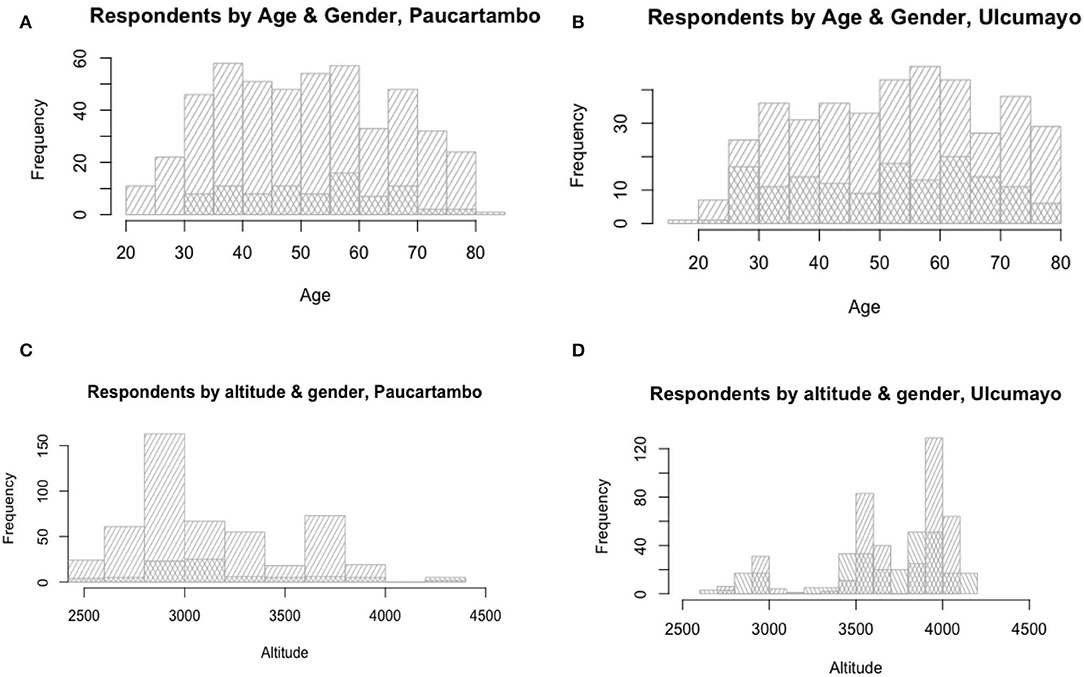
Figure 1. Frequency histograms of respondents by age and gender in Paucartambo (A) and Ulcumayo (B) and of respondents by altitude for Paucartambo (C) and Ulcumayo (D); males, forward slashed bars; females, hatched bars.
Education was strongly associated with age in both locations (Table 1). Lack of education occurred only in the older age groups and secondary education was associated primarily with the youngest age class. Fisher's exact tests for independence of age/gender class and education were highly significant in both Paucartambo (p < 0.0001) and Ulcumayo (p < 0.0001).
Based on frequency histograms, both female and male respondents were farming at all altitudes in both locations (Figures 1C,D), however, in general, potato production was generally done at higher altitudes in Ulcumayo. At that location, 93% of production occurred above 3,000 masl, while in Paucartambo, only 51% of production occurred above 3,000 masl (calculated from Table 2). Age/gender classes were less clearly associated with altitude (Table 2); however, Chi-square tests of independence of age/gender classes and altitude were significant for both Paucartambo (p = 0.0065) and Ulcumayo (p = 0.0218).
Production Constraints, Causes of LB and Sources of Knowledge
Nearly all respondents in both locations identified LB as the primary constraint to potato production, while Andean weevil was considered the second most important constraint in both locations (Figure 2A). Other constraints were identified by 15% or fewer of respondents and a Fisher's exact test of independence between location and choice of constraint was highly significant (p < 0.0001). Respondents in both locations also considered that LB is primarily caused by a combination of sun, rain and fog, while other factors were considered less important (Figure 2B). As a slight exception, 25% of respondents in Paucartambo considered rain alone to be most important (Figure 2B). There were no significant gender differences in their perceptions on the primary constraint to potato production (Figures 3A,B), nor in the causes of LB (Figures 3C,D). In both locations, over 80% of respondents chose one of two sources of information: agrochemical vendor or self, with the former slightly more important in Paucartambo and the latter slightly more important in Ulcumayo (Figure 2C). None of the other sources of information were chosen by over 10% of respondents. Chi-square tests, based on the first four choices in each case, indicated that responses in the two locations were significantly different for primary constraint, causes of LB and source of information. There was a significant difference in information sources between men and women respondents in both locations (Figures 3E,F). Women respondents tended to rely on information from agrochemical vendors rather than self. Extension agents and institutions are not a major source of information for women as well as men.
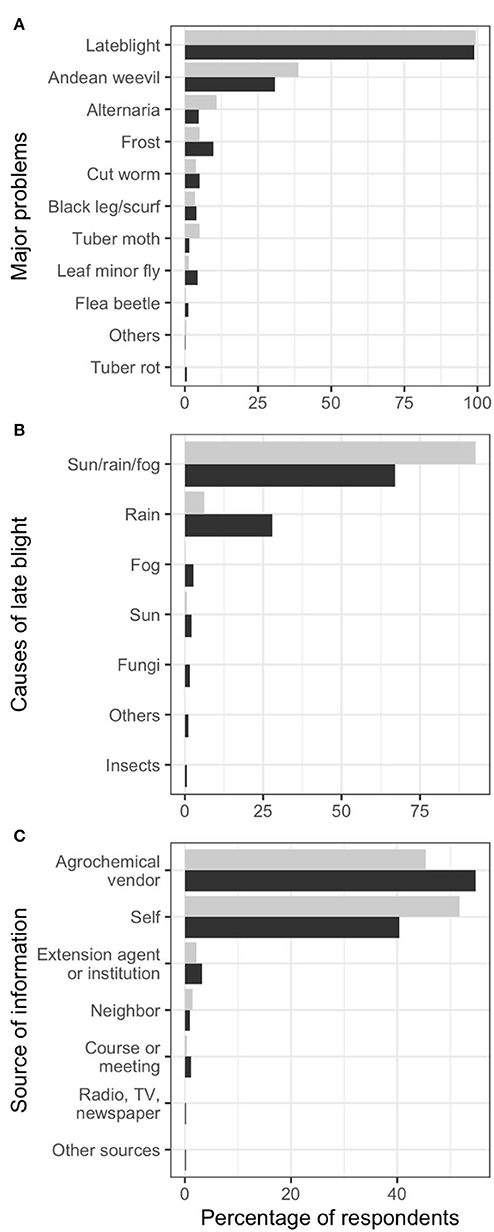
Figure 2. Percentage of respondents choosing specific potato pests and diseases as the primary problem (A), causes of late blight (B), and sources of information to control late blight (C) Legend: black, Paucartambo; gray, Ulcumayo. Fisher's exact test for independence of location and the factor in question was highly significant in all three cases.
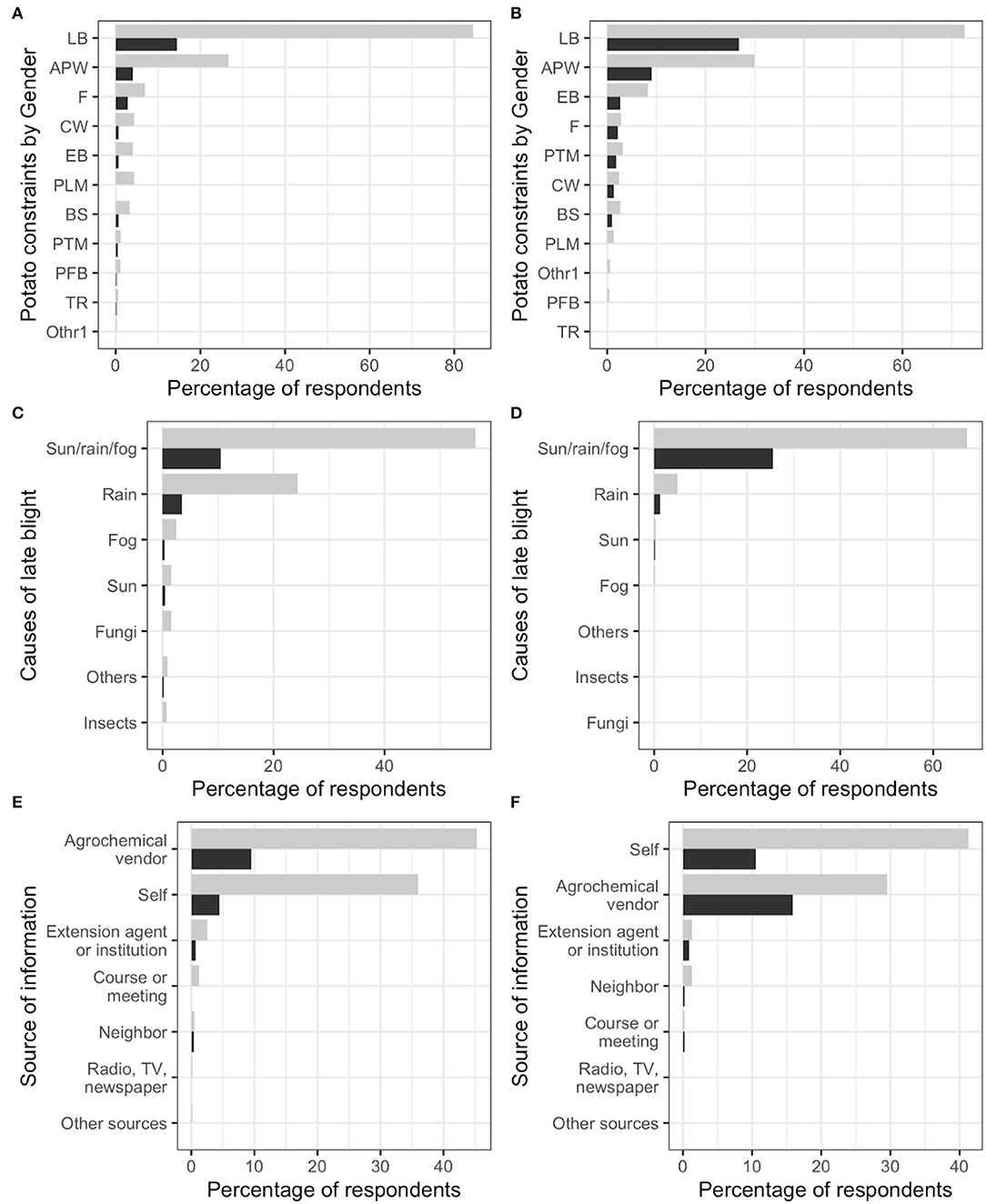
Figure 3. Effects of gender on the most important constraints (A,B), factors causing late blight (C,D) and sources of information (E,F) in the communities of Paucartambo (A,C,E) and Ulcumayo (B,D,F). Gray bars represent men and black bars represent women. Fisher's exact tests of independence indicated that there was no effect of gender for important constraints nor causes of late blight in either location, while for source of information, gender was not significant in Paucartambo (p = 0.1085) and highly significant in Ulcumayo (p < 0.001).
Most Widely Grown Potato Cultivars and Those Considered Susceptible or Resistant to LB
Respondents in Paucartambo and Ulcumayo identified 21 and 26 potato cultivars, respectively (Supplementary Material 3). Yungay was the most important in both locations (the 15 most widely grown are shown in Figure 4A). Huayro, Canchan, Chaulina, Peruanita, Tumbay, and Andina were also important but to a varying degree in each location. Some less important cultivars were grown only in one location. Locations were significantly different for cultivars recalled (p < 0.0001) based on Fisher's exact test of independence (Figure 4A). The profiles of the number of cultivars grown per farmer were similar in both locations, but there was a slight yet significant (p < 0.0001) tendency for farmers in Ulcumayo to grow more cultivars (Figure 4B).
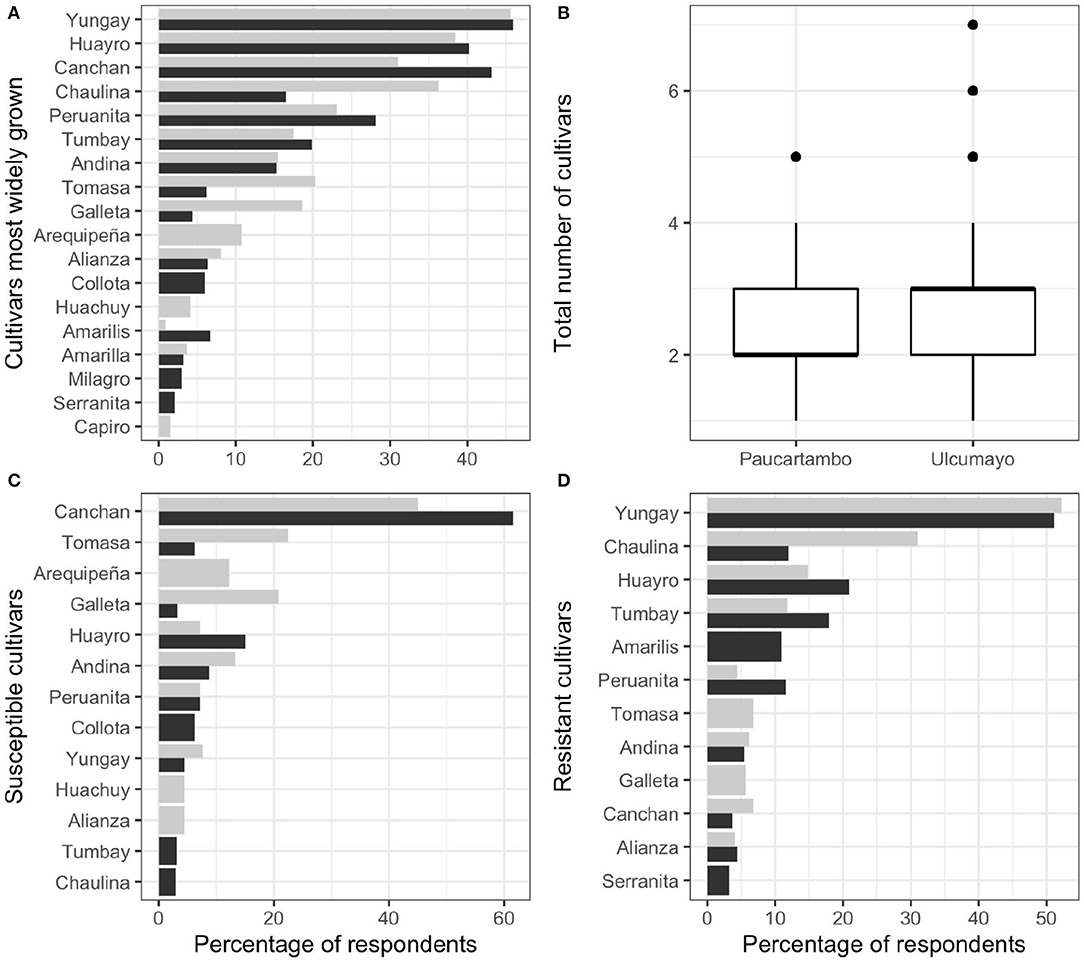
Figure 4. Percentage of respondents choosing cultivars most widely grown (15 most important, A), number of cultivars per farmer (B), susceptible to late blight (C), and resistant to late blight (D) in Paucartambo, black bars; Ulcumayo, gray bars. Fisher's exact tests (A,C,D) for independence of factors were highly significant (p < 0.0001), as was the Wilcoxon rank sum for differences in means (B, p < 0.0001).
Respondents in both locations chose Canchan as the cultivar most susceptible to LB (Figure 4C). Otherwise, the locations differed in their perceptions of susceptible varieties. The cultivar Yungay was chosen by over 50% of respondents in both locations as the most resistant to LB (Figure 4D). Chaulina, more popular in Ulcumayo (Figure 4A), was also chosen by over 30% of respondents in that location. Other than the first choice, and similar to the choice of susceptible cultivars, respondents in the two locations often had different views of resistant cultivars. The cultivar Huayro was chosen by respondents in Paucartambo as both the second most resistant and second most susceptible to LB. The cultivar Tomasa was the second most susceptible and fifth most resistant for respondents in Ulcumayo (Figures 4C,D). Location differences for selection of resistant and susceptible cultivars were significant (p < 0.0001), based on Fisher's exact test of independence.
Fungicide Use
In both locations respondents recalled well over 30 trade products, but also in each location about half were named by fewer than 1% of participants and a few participants gave products that are not fungicides (e.g., the insecticide Furadan, Figure 5A), but this was rare. In both locations the order of importance of trade products were relatively similar (Figure 5A). The trade name of a fungicide most frequently given was Antracol, recalled by nearly 50% of respondents in both locations. Dithane, the second most common, was given by slightly over 45% of respondents in both locations and Curzate, the third most common, by over 30% of respondents in both locations. After that, recalled trade names differed between locations. Only those named by at least 1% of respondents are presented (Figure 5A), and products that appear to be unique to one location (e.g., Manzate in Ulcumayo, Figure 5A), may have been present in the other location but were mentioned by fewer than 1% of respondents.
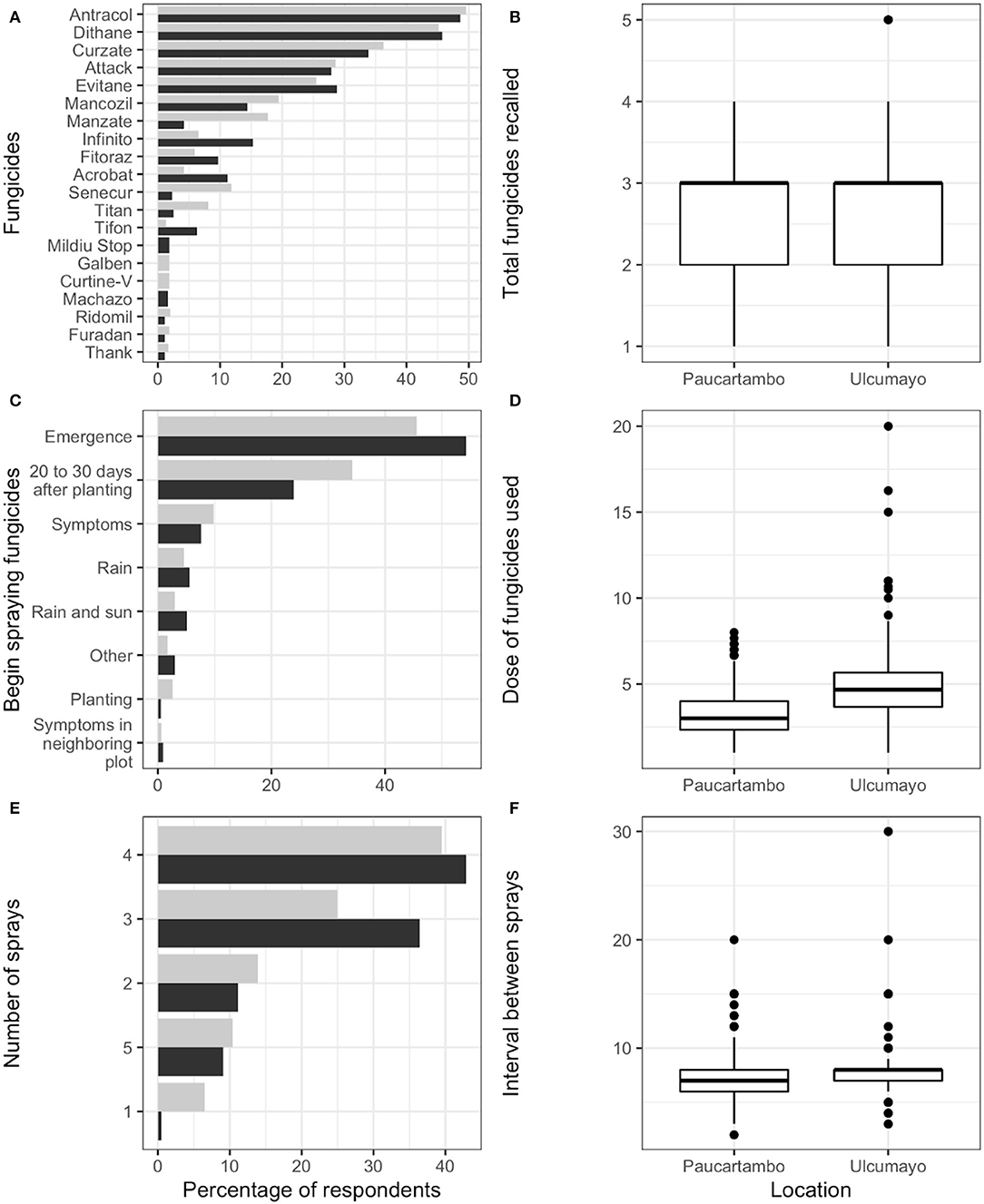
Figure 5. Percentage of respondents choosing most widely used fungicides, of which those with at least 1% of respondents are shown here (A), total number of fungicides (B), reason for initiating the first late blight spray (C), dose of fungicides per 20 l sprayer (D) scaled number of sprays [(1, fewer than 5 sprays; 2, between 6 and 10 sprays; 3, between 11 and 15 sprays; 4, between 16 and 20 sprays; 5, more than 20 sprays)] (E), and interval between sprays (F) in Paucartambo, black bars; Ulcumayo, gray bars. Chi-square tests (A,C,E) for independence of factors were significant, as were the Wilcoxon rank sum tests for differences in means (B,D,F).
Similar numbers per respondent of fungicide trade names were recalled in both locations, producing nearly identical box plots (Figure 5B). However, respondents in Ulcumayo on average recalled a slightly higher number of fungicides at 2.76 than did respondents in Paucartambo, with 2.63 (data not shown), driven in part by a small number of people in Ulcumayo who recalled 5 trade fungicide names. The difference between locations was significant based on a Wilcoxon rank sum test (p < 0.0011). Locations also had similar response patterns for reasons for initiating LB control sprays, but here respondents primarily chose one of two, emergence or 20–30 days post emergence, with the former being most important (Figure 5C). Environmental triggers such as rainfall, were not frequently chosen. A Chi-square test for independence of locations was significant at p = 0011 as, proportionally, fewer respondents in Ulcumayo chose emergence as the primary trigger for spraying.
Locational differences were slightly significant (p < 0.000) for dose of fungicide used per 20 l sprayer based on Wilcoxon rank sum tests (Figure 5D). Respondents in Paucartambo tended to spray more frequently than did those in Ulcumayo, with a larger percentage from the former choosing spray scale levels 3 and 4, representing between 11 and 20 sprays per season (Figure 5E). The interval between fungicide sprays was approximately 1 week in each location but farmers in Ulcumayo tended to have a slightly longer interval and there was more variation among farmers in this location (Figure 5F). Locational differences were highly significant (p < 0.000) for both number of sprays and spray interval, based on Wilcoxon rank sum tests.
Yield
Respondents in Paucartambo estimated potential yield to be slightly higher than did respondents in Ulcumayo, with median values of 25 and 20 bags per ha (bag = 70 kg), respectively (Figure 6A), but estimated slightly lower percentage loss due to LB, if fungicides were not used (Figure 6B). In both locations, potential loss was estimated to be above 50%. Locational differences were highly significant (p < 0.0001) for both potential yield and yield loss based on Wilcoxon rank sum tests.
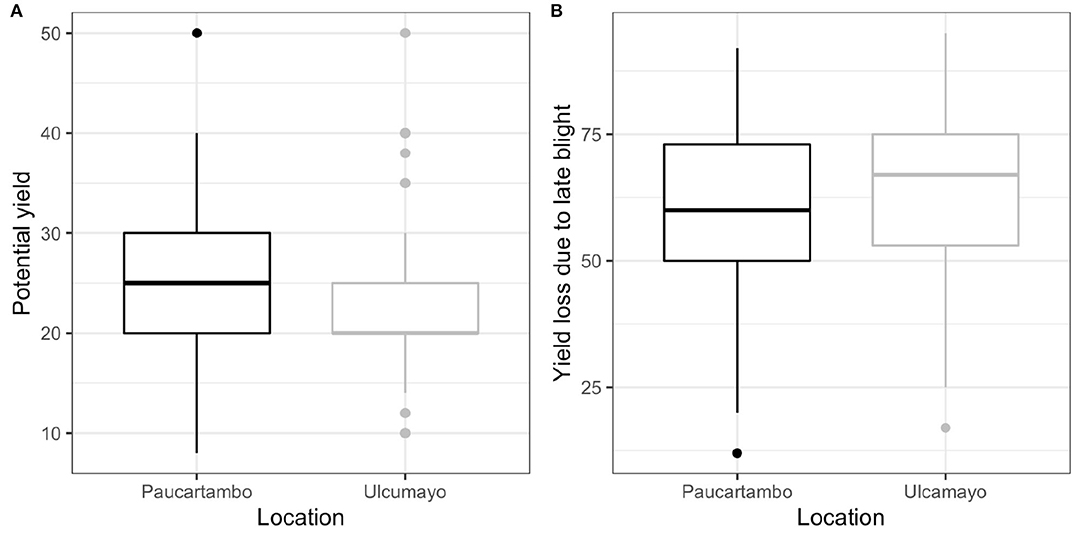
Figure 6. Potential yield with no damage from late blight (bags of 70 kg per ha), as estimated by respondents in Paucartambo and Ulcumayo (A), and estimates of respondents from both locations for percent loss due to late blight if fungicides are not used and the disease is present (B). Locational differences were highly significant (p < 0.0001) for both potential yield and yield loss based on Wilcoxon rank sum tests.
Correspondence Analysis
In both locations, there was a relatively strong association of factors based on gender. Women of all ages generally clustered together. Mid aged men in Paucartambo (Figure 7) and young men in Ulcumayo (Figure 8) were projected on the biplot relatively distant from other respondents of the same gender, but it was nonetheless possible to make some inferences about potential gender-based perceptions of disease and crop management practices, as there were several associations among respondent characteristics and management practices that were similar in both locations. For example, in both locations, men of all ages tended to be associated with basing the first spray on a calendar, recalling a relatively high number (3–7) of fungicides, recalling systemic fungicides, and relying on personal experience as a source of information. In both locations women tended to observe others for first spray cues, recalled fewer fungicides, generally recalled contact fungicides and got information from outside sources. Some perceptions were not consistent across locations. For example, cultivar Yungay was considered resistant by women in Paucartambo and by men in Ulcumayo. A number of other perceptions were not clearly associated with gender. There was also no clear pattern associated with the ages of respondents.
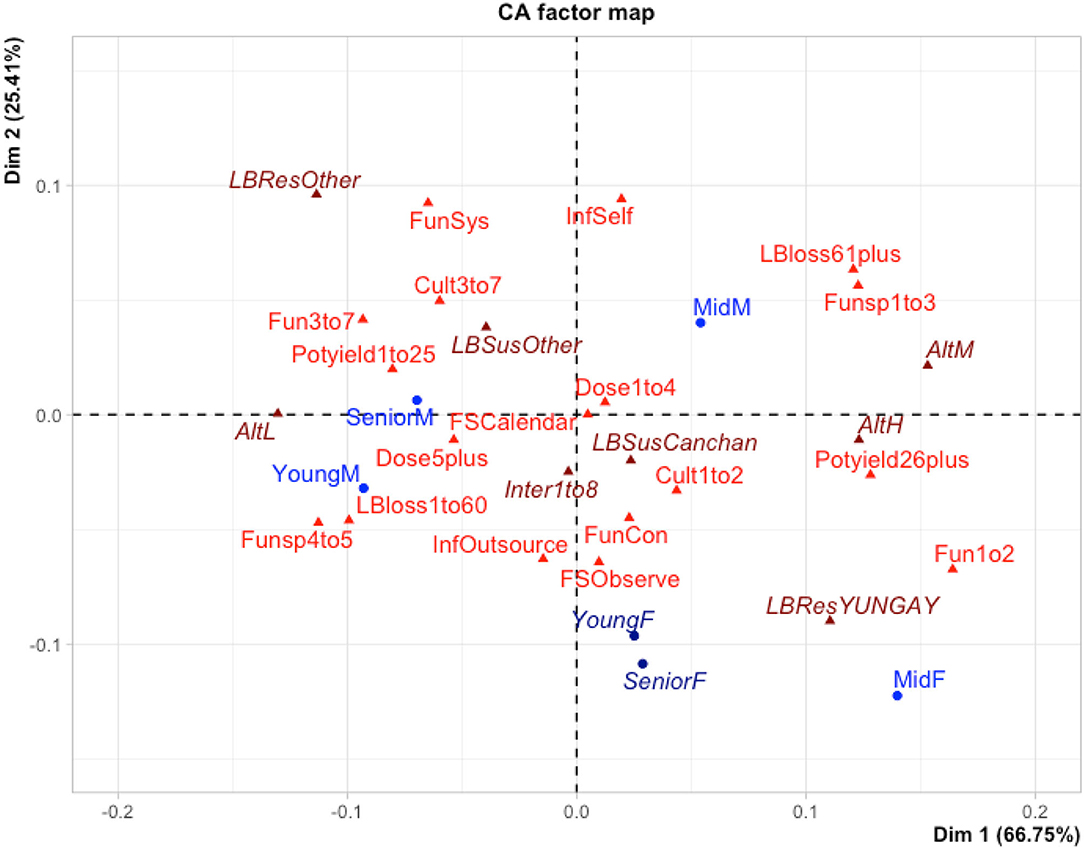
Figure 7. Correspondence analysis biplot for characteristics and responses of respondents from Paucartambo. Color code: dark blue, respondent age-gender classes that form the rows in the contingency table; light blue, respondent age-gender classes used as supplementary rows; red, management choices in the form of discretized variables that form the columns in the contingency table; brown, management choices used as supplementary columns.
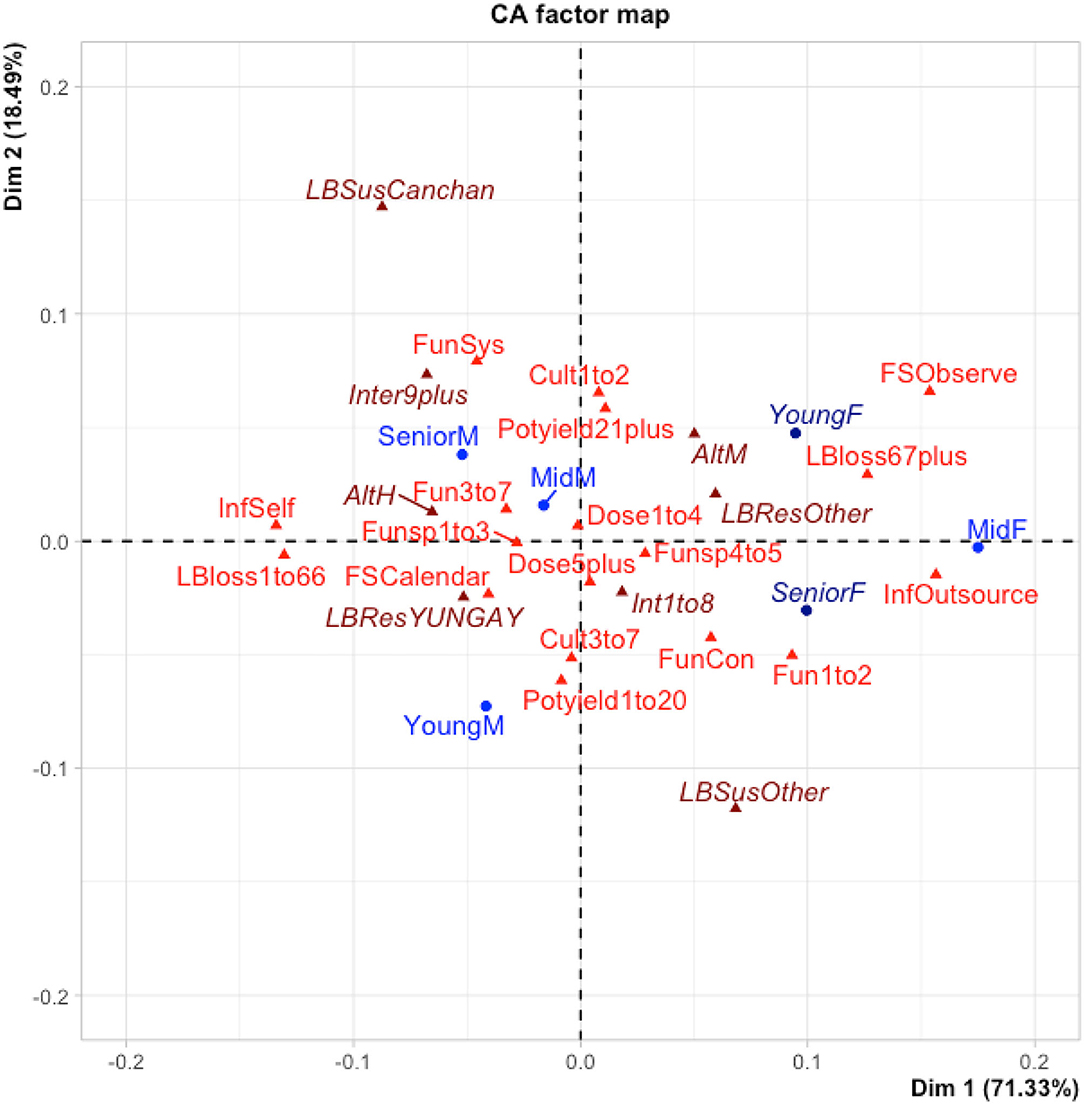
Figure 8. Correspondence analysis biplot for characteristics and responses of respondents from Ulcumayo. Color code: dark blue, respondent age-gender classes that form the rows in the contingency table; light blue, respondent age-gender classes used as supplementary rows; red, management choices in the form of discretized variables that form the columns in the contingency table; brown, management choices used as supplementary columns.
Discussion
Perception About Late Blight
Similar to a number of other studies in highland tropical locations (Kromann et al., 2009; Monteros and Delgado, 2021), respondents in both locations considered LB to be the primary constraint to potato production. As mentioned, and discussed in more detail below, LB is particularly difficult to manage in the highland tropics where potato or other wild hosts of P. infestans are present year-round. The difficulty of LB in the survey regions is also implied by the large number of fungicide sprays per season (Figure 5E). Increased capacity building for LB management and/or new technologies such as resistant varieties could provide major benefits for resource poor farmers in these conditions. Participants were not asked directly about interactions with public or private extension services, but these institutions were not frequently cited as sources of information for LB management. Most respondents either relied on their own knowledge or consulted agrochemical vendors (Figures 3E,F). Thus, either there had been few or no previous interventions for improving LB management in the communities or they did not have lasting impact. This issue could be addressed in a future intervention by offering refresher training courses for extension educators, including female extension workers, with participatory farmer field school approaches (Ortiz et al., 2004).
Cultivars
The most important potato cultivars in both locations are relatively old and come from the breeding programs of the national potato program or CIP. This most likely indicates that most of the respondents target larger urban markets where these cultivars are popular, while keeping native varieties for home consumption. While the older cultivars have market value, they are relatively susceptible to P. infestans. To stimulate use of newer and more resistant cultivars that require less fungicide to control LB, future development activities should involve market analysis and eventually market interventions that consider the environmental impact of these varieties (Kovach et al., 1992), to identify consumers willing to buy tubers from resistant varieties and, therefore, stimulate farmers to adopt them. CIP has developed a Participatory Market Chain Approach (PMCA, Bernet et al., 2006) that brings together market chain actors to identify and support innovations, which in the past has involved development of markets for new cultivars.
There were inconsistencies in the recognition of cultivars as either resistant or susceptible, with several appearing relatively high in both lists (Figures 3C,D), and this occurred in both locations. Furthermore, most of the resistant varieties cited are not known by researchers to possess important levels of resistance and Yungay, chosen as resistant in both locations, is generally considered susceptible (Wulff et al., 2007; Lindqvist-Kreuze et al., 2014). Serranita is known to have relatively high resistance, but it was only rarely mentioned by respondents (Figure 4D). This could indicate that farmers know the resistance of some varieties in their own locations which we are not aware of, or they do not have a clear understanding of the role of host resistance in managing potato late blight, or that, other than Serranita, they are not aware of or do not have access to resistant cultivars. This highlights an important research question as to whether the lack of consensus on use of resistance is due to farmer perceptions, unavailability of resistant germplasm, or both.
Fungicides
The responses of participants to questions related to fungicide use (Figure 4) demonstrated some commonalities across the two locations. Most of the fungicides recalled were older chemistries. According to the fungicide table of the Euroblight Network (EuroBlight, 2021), the active ingredients used in the trade products that respondents recalled were all released before 2007, and many of the new active ingredients were not mentioned in the responses.
The most recalled trade product in both locations was Antracol, which contains the contact fungicide propineb. Beyond that, most of the commonly recalled products contained mancozeb, a broad-spectrum contact fungicide released in the 1940s, which, when all fungicides are considered, is certainly the most common active ingredient used in both locations. Environmental and human health risks of excessive use of mancozeb have led to increasing pressure from environmental groups to ban the fungicide (Reuveni, 2021) and the global potato industry is anticipating the loss of mancozeb in the near future (Anonymous, 2021). The third and fifth most frequently recalled products contain the translaminar fungicide cymoxanil, and overall, 30% of products recalled contain a translaminar or systemic ingredient (data not shown), indicating a relatively frequent use of these more effective and more expensive compounds. It is not known, however, whether respondents understood the difference between contact fungicides and those with more mobility in plant tissue. Reasons for the apparent gender association with contact and systemic/translaminar products are also not clear. Overall, the question remains whether newer fungicides are available in the communities, and if so, are they not used because of the high cost or because farmers are not aware of their efficacy.
Survey results gave indirect evidence of the difficulty of managing LB under highland tropical conditions. In both locations the majority of respondents said that they initiate fungicide spraying at emergence, with the second most important period between 20 and 30 days after planting (Figure 5C). This indicates that farmers consider that plants could be infected at emergence or at least in very early stages of growth and thus crops must be protected during the majority of the growing season. Other studies in the Andean region have also found that very early infection is a common threat due to year-round climate propitious to potato growth (Garrett et al., 2001). Research has also demonstrated that it is possible for potato sprouts to be infected prior to emergence by aerially deposited spores of P. infestans (Kromann et al., 2008). The predominance of fungicide application at or soon after emergence may also indicate a lack of knowledge or equipment that would permit farmers to use weather-based indicators. However, if inoculum is present at emergence, there would seem to be no alternative to early application of fungicides.
Correspondence Analysis
The gender effect evident in both CA's confirms previous studies that show that women and men farmers often have different perceptions of management issues (e.g., Kawarazuka et al., 2020). This survey identified important gender differences, such as men tended to rely on personal experience in their decisions on LB management. Men also tended to spray a relatively higher number of fungicides than did women farmers. Men's reliance on their experience might be associated with their limited training opportunities or little trust in extension services. Therefore, specific training and visible evidence through demonstration fields may induce men as well as women to change their practices to utilize scientific information such as DSS instead of following their own decisions. Reaching women farmers is another challenge. While women play significant roles in potato production in Peru, potato farmer organizations are dominated by male farmers with a small number of women who tend to be highly educated and hold land titles (Patel-Campillo and García, 2018). Therefore, providing LB training through potato farmer organizations may not be effective for reaching many women farmers. The literature in other regions shows that agricultural programs with a clear target for women farmers can significantly increase women's access to information on crop management (Akter et al., 2016; Mudege et al., 2016; Williams and Taron, 2020). Offering tailored training to meet women's specific needs is our priority. To effectively reach women, alternative approaches, such as engaging with women's social groups through NGOs can be tested in the Peruvian Andes.
The questionnaire used in this study gave a good overview of farmer perceptions related to LB management practices. The questionnaire could potentially be improved by linking it to multi-indicator surveys (e.g., Hammond et al., 2017) where social scientists, pathologists, agronomists and occupational health workers can include questions to capture information related to potato crop management. An improved questionnaire could eventually become a tool for simplifying and facilitating baseline studies where LB is important.
Any recommendations for future interventions should take into consideration that the occurrence of the COVID-19 pandemic has dramatically changed training for farmers. Sessions programmed in Farmers Field Schools (FFS), field days and local meetings have recently been canceled to reduce physical contact to a strict minimum to avoid spreading the virus SARS-CoV-2. In this context, and although there are still many challenges in remote areas to access and utilize internet for agriculture, digital apps are being prioritized have a great potential, especially with young farmers, to transform extension in areas where internet is available.
Data Availability Statement
The data sets presented in this study can be found in online repositories. The names of the repository/repositories and accession number(s) can be found in Perez et al. (2021a,b). The Rcode has been published by Forbes (2022).
Author Contributions
WP and JA-P: study concept and design. WP and RA: acquisition of data. GF, WP, JA-P, and NK: analysis and interpretation of data. GF, WP, and JA-P: statistical analysis. GF, WP, JA-P, WP, NK, and RA: drafting of the manuscript. All authors: critical revision and final approval of the manuscript.
Funding
This research was undertaken as part of, and funded by, the CGIAR Research Program on Roots, Tubers and Bananas (RTB) and supported by CGIAR Trust Fund contributors (https://www.rtb.cgiar.org/) and The OPEC Fund for International Development (OFID), Austria (https://opecfund.org/).
Conflict of Interest
The authors declare that the research was conducted in the absence of any commercial or financial relationships that could be construed as a potential conflict of interest.
Publisher's Note
All claims expressed in this article are solely those of the authors and do not necessarily represent those of their affiliated organizations, or those of the publisher, the editors and the reviewers. Any product that may be evaluated in this article, or claim that may be made by its manufacturer, is not guaranteed or endorsed by the publisher.
Acknowledgments
We are thankful for the collaboration of H. Tamayo, N. Santos, and M. Barreto, Daniel Alcides Carrión National University (UNDAC) who participated in the survey.
Supplementary Material
The Supplementary Material for this article can be found online at: https://www.frontiersin.org/articles/10.3389/fsufs.2022.873490/full#supplementary-material
References
Adolf, B., Andrade-Piedra, J., Bittara Molina, F., Przetakiewicz, J., Hausladen, H., Kromann, P., et al. (2020). “Fungal, oomycete, and plasmodiophorid diseases of potato,” in The Potato Crop, eds H. Campos and O. Ortiz (Cham: Springer International Publishing), 307–350. doi: 10.1007/978-3-030-28683-5_9
Akter, S., Krupnik, T. J., Rossi, F., and Khanam, F. (2016). The influence of gender and product design on farmers' preferences for weather-indexed crop insurance. Glob. Environ. Change. 38, 217–229. doi: 10.1016/j.gloenvcha.2016.03.010
Anonymous (2021). Mancozeb: Why the Potato Industry Must Prepare for Its Loss. Farmers Wkly. Available online at: https://www.fwi.co.uk/arable/crop-management/disease-management/mancozeb-why-the-potato-industry-must-prepare-for-its-loss (accessed: November 11, 2021).
Bernet, T., Thiele, G., and Zschocke, T. (2006). Participatory Market Chain Approach (PMCA) - User Guide. Lima: International Potato Center (CIP)- Papa Andina.
Cole, D. C., Sherwood, S., Paredes, M., Sanin, L. H., Crissman, C., Espinosa, P., et al. (2007). Reducing pesticide exposure and associated neurotoxic burden in an Ecuadorian small farm population. Int. J. Occup. Environ. Health. 13, 281–9. doi: 10.1179/oeh.2007.13.3.281
Damtew, E., Leeuwis, C., Struik, P. C., Cecchi, F., van Mierlo, B., Lie, R., et al. (2020). Communicative Interventions for Collective Action in the Management of Potato Late Blight: Evidence From a Framed Field Game Experiment in Ethiopia. Food Secur. Available at: http://link.springer.com/10.1007/s12571-020-01120-0 [Accessed December] 23, 2020]. doi: 10.1007/s12571-020-01120-0
Devaux, A., Goffart, J.-P., Petsakos, A., Kromann, P., Gatto, M., Okello, J., et al. (2020). “Global food security, contributions from sustainable potato agri-food systems,” in The Potato Crop, eds H. Campos and O. Ortiz (Cham: Springer International Publishing), 3–35. doi: 10.1007/978-3-030-28683-5_1
EuroBlight (2021). Late Blight Fungicide Table. Available online at: https://agro.au.dk/forskning/internationale-platforme/euroblight/control-strategies/late-blight-fungicide-table/ (accessed: September 2, 2021).
Forbes, G. (2022). R Code for Farmer Perceptions Related to Potato Production and Late Blight Management in Two Communities in the Peruvian Andes. doi: 10.6084/m9.figshare.19027331.v2
Förch, W., Kristjanson, P., Cramer, L., Barahona, C., and Thornton, P. K. (2014). Back to baselines: measuring change and sharing data. Agric. Food Secur. 3:13. doi: 10.1186/2048-7010-3-13
Garrett, K. A., Nelson, R. J., Mundt, C. C., Chacón, G., Jaramillo, R. E., and Forbes, G. A. (2001). The effects of host diversity and other management components on epidemics of potato late blight in the humid highland tropics. Phytopathology. 91, 993–1000. doi: 10.1094/PHYTO.2001.91.10.993
Hammond, J., Fraval, S., Van Etten, J., Suchini, J. G., Mercado, L., Pagella, T., et al. (2017). The Rural Household Multi-Indicator Survey (RHoMIS) for rapid characterisation of households to inform climate smart agriculture interventions: Description and applications in East Africa and Central America. Agric. Syst. 151, 225–233. doi: 10.1016/j.agsy.2016.05.003
Haverkort, A. J., Struik, P. C., Visser, R. G. F., and Jacobsen, E. (2009). Applied biotechnology to combat late blight in potato caused by Phytophthora Infestans. Potato Res. 52, 249–264. doi: 10.1007/s11540-009-9136-3
Kawarazuka, N., Damtew, E., Mayanja, S., Okonya, J. S., Rietveld, A., Slavchevska, V., et al. (2020). A gender perspective on pest and disease management from the cases of roots, tubers and bananas in Asia and sub-Saharan Africa. Front. Agron. 2:7. doi: 10.3389/fagro.2020.00007
Kovach, J., Petzoldt, C., Degni, J., and Tette, J. (1992). A Method to Measure the Environmental Impact of Pesticides. New Yorks Food Life Sci. Bull. 139, 1–8.
Kromann, P., Taipe, A., Andrade-Piedra, J. L., Munk, L., and Forbes, G. A. (2008). Preemergence Infection of Potato Sprouts by Phytophthora infestans in the Highland Tropics of Ecuador. Plant Dis. 92:569–574. doi: 10.1094/PDIS-92-4-0569.
Kromann, P., Taipe, A., Perez, W. G., and Forbes, G. A. (2009). Rainfall thresholds as support for timing fungicide applications in the control of potato late blight in Ecuador and Peru. Plant Dis. 93, 142–148. doi: 10.1094/PDIS-93-2-0142
Lindqvist-Kreuze, H., Gastelo, M., Perez, W., Forbes, G. A., de Koeyer, D., and Bonierbale, M. (2014). Phenotypic stability and genome-wide association study of late blight resistance in potato genotypes adapted to the tropical highlands. Phytopathology. 104, 624–633. doi: 10.1094/PHYTO-10-13-0270-R
Monteros, A., and Delgado, R. (2021). Late blight resistance of Ecuadorian potato landraces: field evaluation and farmer's perception. Rev. Fac. Agron. 38, 505–524. doi: 10.47280/RevFacAgron(LUZ).v38.n3.03
Mudege, N. N., Chevo, T., Nyekanyeka, T., Kapalasa, E., and Demo, P. (2016). Gender norms and access to extension services and training among potato farmers in Dedza and Ntcheu in Malawi. J. Agric. Educ. Ext. 22, 291–305. doi: 10.1080/1389224X.2015.1038282
Nenadic, O., and Greenacre, M. (2007). Correspondence analysis in R, with two-and three-dimensional graphics: the ca package. J. Stat. Softw. 20, 1–13. doi: 10.18637/jss.v020.i03
Nowicki, M., Foolad, M. R., Nowakowska, M., and Kozik, E. U. (2012). Potato and tomato late blight caused by Phytophthora infestans: an overview of pathology and resistance breeding. Plant Dis. 96, 4–17. doi: 10.1094/PDIS-05-11-0458
Nyankanga, R. O., Wien, H. C., Olanya, O. M., and Ojiambo, P. S. (2004). Farmers' cultural practices and management of potato late blight in Kenya highlands: implications for development of integrated disease management. Int. J. Pest Manag. 50, 135–144. doi: 10.1080/09670870410001691812
Okonya, J. S., Mudege, N. N., Nyaga, J. N., and Jogo, W. (2021). Determinants of women's decision-making power in pest and disease management: evidence from Uganda. Front. Sustain. Food Syst. 5:693127. doi: 10.3389/fsufs.2021.693127
Ortiz, O., Garrett, K. A., Heath, J. J., Orrego, R., and Nelson, R. J. (2004). Management of potato late blight in the Peruvian highlands: evaluating the benefits of farmer field schools and farmer participatory research. Plant Dis. 88, 565–571. doi: 10.1094/PDIS.2004.88.5.565
Ortiz, O., Winter, P., Fano, H., Thiele, G., Guaman, S., Torres, R., et al. (1999). Understanding Farmers' Responses to Late Blight: Evidence From Peru, Bolivia, Ecuador, and Uganda. In Impact on a Changing World: Program Report. 1997–98. Lima: International Potato Center, p. 101–109.
Pacilly, F. C. A., Groot, J. C. J., Hofstede, G. J., Schaap, B. F., and van Bueren, E. T. L. (2016). Analysing potato late blight control as a social-ecological system using fuzzy cognitive mapping. Agron. Sustain. Dev. 36:35. doi: 10.1007/s13593-016-0370-1
Patel-Campillo, A., and García, V. B. S. (2018). Un/associated: accounting for gender difference and farmer heterogeneity among Peruvian Sierra potato small farmers. J. Rural Stud. 64, 91–102. doi: 10.1016/j.jrurstud.2018.10.005
Perez, W., Andrade-Piedra, J., Forbes, G., and Arias, R. (2021a). Dataset for: Farmers' Perception on Late Blight in Peruvian Highlands - Paucartambo. Pasco: International Potato Center. doi: 10.21223/6YLYT9
Perez, W., Andrade-Piedra, J., Forbes, G., and Arias, R. (2021b). Dataset for: Farmers' Perception on Late Blight in Peruvian highlands - Ulcumayo. Junin: International Potato Center. doi: 10.21223/ZGHXVU
Pérez, W., Arias, R., Taipe, A., Ortiz, O., Forbes, G. A., Andrade-Piedra, J., et al. (2020). A simple, hand-held decision support designed tool to help resource-poor farmers improve potato late blight management. Crop Prot. 134:105186. doi: 10.1016/j.cropro.2020.105186
R Core Team (2018). R: A Language and Environment for Statistical Computing. Vienna, Austria: R Foundation for Statistical Computing. Available online at: https://www.R-project.org/.
Reuveni, M. (2021). Replacing mancozeb with tea tree oil-based timorex gold for the successful control of black sigatoka and the reduction of chemical load in banana plantations. Ind. Biotechnol. 17, 239–241. doi: 10.1089/ind.2021.29262.rme
Sherwood, S., and Bentley, J. (1995). Rural Farmers Explore Causes of Plant Disease. Ileia Newsl.:20–22.
Sparks, A. H., Forbes, G. A., Hijmans, R. J., and Garrett, K. A. (2014). Climate change may have limited effect on global risk of potato late blight. Glob. Change Biol. 20, 3621–3631. doi: 10.1111/gcb.12587
Tafesse, S., Damtew, E., van Mierlo, B., Lie, R., Lemaga, B., Sharma, K., et al. (2018). Farmers' knowledge and practices of potato disease management in Ethiopia. NJAS Wagening. J. Life Sci. 86–87, 25–38. doi: 10.1016/j.njas.2018.03.004
Williams, F. E., and Taron, A. (2020). Demand-led extension: a gender analysis of attendance and key crops. J. Agric. Educ. Ext. 26, 383–400. doi: 10.1080/1389224X.2020.1726778
Keywords: farmers, perceptions, knowledge, gender, potatoes, food security, oomycete, Andes
Citation: Perez W, Forbes GA, Arias R, Pradel W, Kawarazuka N and Andrade-Piedra J (2022) Farmer Perceptions Related to Potato Production and Late Blight Management in Two Communities in the Peruvian Andes. Front. Sustain. Food Syst. 6:873490. doi: 10.3389/fsufs.2022.873490
Received: 10 February 2022; Accepted: 13 April 2022;
Published: 23 May 2022.
Edited by:
Dipayan Sarkar, North Dakota State University, United StatesReviewed by:
Ramesh Raju Vetukuri, Swedish University of Agricultural Sciences, SwedenLori Hoagland, Purdue University, United States
Copyright © 2022 Perez, Forbes, Arias, Pradel, Kawarazuka and Andrade-Piedra. This is an open-access article distributed under the terms of the Creative Commons Attribution License (CC BY). The use, distribution or reproduction in other forums is permitted, provided the original author(s) and the copyright owner(s) are credited and that the original publication in this journal is cited, in accordance with accepted academic practice. No use, distribution or reproduction is permitted which does not comply with these terms.
*Correspondence: Willmer Perez, dy5wZXJlekBjZ2lhci5vcmc=
 Willmer Perez
Willmer Perez Gregory Allan Forbes
Gregory Allan Forbes Rolando Arias
Rolando Arias Willy Pradel
Willy Pradel Nozomi Kawarazuka
Nozomi Kawarazuka Jorge Andrade-Piedra
Jorge Andrade-Piedra